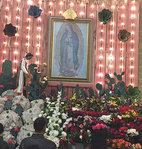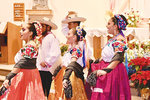

At 4 a.m. on a recent Wednesday, while most of Siler City slept, a full-on celebration was taking place just outside the town.
At St. Julia Catholic Church, congregants were dancing and singing at the annual Our Lady of Guadalupe Feast Day celebration.
For more than 500 years, Our Lady of Guadalupe has been a powerful symbol of devotion and identity for Mexicans, Mexican-Americans, and other Latinos.
“Especially for the Mexican people, this day is so important,” said Father Julio Martinez of St. Julia Catholic Church. “It’s a celebration for the mother of Jesus. But this is open to anyone. We are all welcoming.”
“This is a big celebration locally,” Janet Ramirez, Hispanic Liaison program & volunteer coordinator said. “People who aren’t familiar with this get confused. It’s not a Christmas holiday, even though it is celebrated near Christmas.”
At St. Julia, the morning began with Las Mañanitas, a traditional serenading of Our Lady of Guadalupe. But the celebration itself began two days before with a series of musical performances and dances with more than 200 youths singing and praying together.
“This is a love affair with the people and their mother. There is a saying in Mexico, ‘Mexico is Guadalupe, and Guadalupe is Mexico,’” Martinez said.
A painting of the virgin, who appears pregnant, as symbolized by a black ribbon tied around her stomach, sits at the altar of the church. The congregation brings flowers to rest beside the image as a tribute to the virgin mother.
“People come in, they say prayers, they sing,” Martinez said. “They want to honor their mother. It’s a beautiful thing.”
That evening, Dec. 12, would be even more full, he said.
“There will be nowhere to sit. We will sing and dance, and then we eat. December 12 is the feast day, so we will all eat together after the mass and the folk dancing.
“Typically, for the feast day, tamales are served,” Martinez said. “That’s a staple of the feast. But over the weekend, we had some issues with the winter weather, so we had tamales and pizza. It’s very fitting for the younger kids who are growing up here.”
The origin story of Our Lady of Guadalupe dates back to Juan Diego, a native Mexican peasant. According to the story, Diego experienced a vision of a young woman on December 9, 1531, at a place called the Hill of Tepeyac, which later became a suburb of Mexico City called Villa de Guadalupe.
The woman spoke to Diego in his native Nahuatl language, and identified herself as the Virgin Mary. She asked for a church to be built at that site in her honor.
Diego met with the archbishop of Mexico, Fray Juan de Zumárraga to tell him about the vision. The bishop, however, did not believe Diego. Later that day, he saw the vision of the Virgin Mary again. She asked him to continue asking for the church to be built.
The next day, Diego met with the archbishop again. The bishop asked Diego to return to Tepeyac Hill and ask the lady for a miraculous sign to prove her identity. He returned to Tepeyac later that day and encountered the vision for a third time. He returned to the bishop and said that she consented to provide a sign the next day.
But the next day Diego’s uncle fell sick, and he was obligated to take care of him. In the early hours of December 12, his uncle’s condition had worsened. He left to find a Catholic priest to hear his uncle’s confession and help minister to him on his death-bed.
Ashamed of being unable to meet the Virgin Mary the day before, he chose a path around Tepeyac. Instead, he was intercepted by the vision and asked where he was going. He explained why he was unable to meet her. She gently scolded him for not seeking her help. She asked, “Am I not here, I who am your mother?”
Those words are now inscribed in Spanish over the main entrance of the Basilica of Guadalupe. She told Diego that his uncle would fully recover and she instructed him to gather flowers from the top of Tepeyac Hill. The area of Tepeyac was normally barren, but still he found Castilian roses, a flower not native to Mexico.
The Virgin arranged the flowers in Diego’s cloak. Later, he opened his cloak before archbishop Zumárraga on December 12, the flowers fell to the floor, and on the fabric was the image of the Virgin of Guadalupe.
The next day, Diego’s uncle was fully recovered. His uncle also recounted that he, too. had seen the apparition. He said that the apparition told him to inform the bishop of his miraculous cure, and that she now wanted to be known under the title of Guadalupe.
The Minor Basilica of Our Lady of Guadalupe in Mexico City is the most visited Catholic pilgrimage site in the world, and the world’s third most-visited sacred site. Roughly seven million pilgrims visit the Basilica every year.
“This is a holiday that stays close to Hispanic and Latino people for their whole lives,” Ramirez said. “You see really young people celebrate, and that continues through their whole life. It’s a way to remember where they came from.”